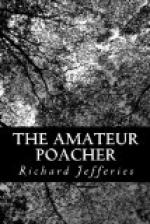The wood pigeons begin to come home, and the wood is filled with their hollow notes: now here, now yonder, for as one ceases another takes it up. They cannot settle for some time: each as he arrives perches awhile, and then rises and tries a fresh place, so that there is a constant clattering. The green woodpecker approaches at a rapid pace—now opening, now closing his wings, and seeming to throw himself forward rather than to fly. He rushes at the trees in the hedge as though he could pierce the thick branches like a bullet. Other birds rise over or pass at the side: he goes through, arrow-like, avoiding the boughs. Instead of at once entering the wood, he stays awhile on the sward of the mead in the open.
As the pheasants generally feed in a straight line along the ground, so the lesser pied woodpecker travels across the fields from tree to tree, rarely staying on more than one branch in each, but, after examining it, leaves all that may be on other boughs and seeks another ahead. He rises round and round the dead branch in the elm, tapping it with blows that succeed each other with marvellous rapidity. He taps for the purpose of sounding the wood to see if it be hollow or bored by grubs, and to startle the insects and make them run out for his convenience. He will ascend dead branches barely half an inch thick that vibrate as he springs from them, and proceeds down the hedge towards the wood. The ‘snop-top’ sounds in every elm, and grows fainter as he recedes. The sound is often heard, but in the thick foliage of summer the bird escapes unseen, unless you are sitting almost under the tree when he arrives in it.
Then the rooks come drifting slowly to the beeches: they are uncertain in their hour at this season—some, indeed, scarce care to return at all; and even when quite dusk and the faint stars of summer rather show themselves than shine, twos and threes come occasionally through the gloom. A pair of doves pass swiftly, flying for the lower wood, where the ashpoles grow. The grasshoppers sing in the grass, and will continue till the dew descends. As the little bats flutter swiftly to and fro just without the hedge, the faint sound of their wings is audible as they turn: their membranes are not so silent as feathers, and they agitate them with extreme velocity. Beetles go by with a loud hum, rising from those isolated bunches of grass that may be seen in every field; for the cows will not eat the rank green blades that grow over and hide dried dung.




